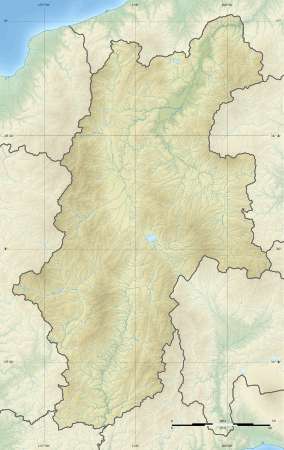Hiraide ruins
Hiraide ruins (平出遺跡, Hiraide iseki) is an archaeological site containing the ruins of a late Jōmon period to early Heian period settlement located in what is now part of the city of Shiojiri, Nagano in the Chūbu region of Japan. The site was designated a National Historic Site of Japan in 1952.[1]
平出遺跡 | |
_houses.jpg) Hiraide Historic Site Park reconstructed pit houses | |
 Hiraide ruins  Hiraide ruins (Japan) | |
| Location | Shiojiri, Nagano, Japan |
|---|---|
| Region | Chūbu region |
| Coordinates | 36°06′13″N 137°56′32″E |
| Type | settlement |
| History | |
| Periods | Jōmon to Heian period |
| Site notes | |
| Ownership | National Historic Site |
| Public access | yes |
Overview
The site is located in a rural area approximately 2 kilometers southwest of Shiojiri Station on the JR Central Line, in the southernmost point of the Matsumoto Plain of central Nagano Prefecture. The ruins are widely spread in strips along the Shibukawa River ranging approximately 1 kilometer east-west by 300 meters north-south, and also encompass threes kofun burial tumuli. The site appears to have been continuously occupied by a large settlement from the late Jōmon period (2000–1000 BCE), and following excavation beginning in 1952, more than 290 pit dwellings, stoneware, earthenware and iron implements have been found.
The Jōmon period remains include 116 pit houses dating to about 4,500 years ago - 5,500 years ago, with pottery and stoneware decorated with luxurious patterns. Also found were many relics and artifacts related to faith such as clay figures and standing stones. No residence sites from the Yayoi period (300 BC–300 AD) have been found, but there was an abundance of Yayoi period pottery artifacts, indicating that the settlement still existed during that time. In the Kofun period (300 to 538 AD), the foundations for over 80 houses have been found, many of large size, and with one or more hearths. Artifacts included many iron implements, carbonized cultivated cereals such as rice and millet, as well as the bones of cattle and horses. Another 50 house sites from the Heian period have also been identified, together with glazed pottery fragments.
The site is now an archaeological park covering 56,450 square meters, with numerous reconstructed buildings, a museum, and public activities.
References
- "平出遺跡" (in Japanese). Agency for Cultural Affairs.
External links
| Wikimedia Commons has media related to Hiraide ruins. |
- Shiojiri city official site (in Japanese)